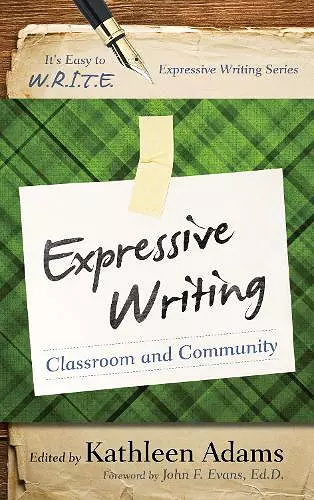Expressive Writing
Classroom and Community
Format:Paperback
Publisher:Rowman & Littlefield
Published:16th Jul '14
Currently unavailable, and unfortunately no date known when it will be back
This paperback is available in another edition too:
- Hardback£70.00(9781475812176)

Expressive writing is life-based writing that focuses on authentic expression of lived experience, with resultant insight, growth and skill-building. Research shows that expressive writing can help in the development of emotional intelligence, better choice-making, and healthy coping skills. In this remarkable collection, 11 experts from education and community service join to offer compelling guidance on applied practice. You’ll discover ·a model for a poetry group for youth at risk; ·how to help students develop inner resources through metaphor; ·a “photovoice” project to help at-risk students stay in school; ·how storytelling develops emotional intelligence in primary school children; ·a method that helps teachers become more confident writers; ·how expressive writing can help teachers manage stress and avoid burn-out; ·expressive writing as change agent for communities; ·the benefits and limitations of writing programs in prisons and jails; ·hip-hop as “the pen of the people”; ·finding a writing group; writing with others; ·the ethics and standards of practice for expressive writing in the classroom and community; ·guidance for all levels of learners: Primary, teens, college-age, adult; professional development, personal growth. Whether you are a teacher, a counselor, a facilitator, or a writer you’ll find this volume an invaluable and innovative resource for expressive writing in the classroom and in the community.
Expressive Writing: Classroom and Community offers practical advice in how to teach writing to people who struggle in their lives and with self-expression. Expressive writing is exciting and transformative. It calls for the best from us as teachers and as people. We learn to listen, we find a way to make a difference, we have a way to care, and we learn to express ourselves. But the world of teaching writing that is open and creative can be daunting. Fortunately, these chapters offer a range of specific practices and important considerations, from how to use poetry in the special education classroom to the ethical issues in requesting personal writing from students and others. Best of all, the authors of these chapters are people you want to learn from, and colleagues you want by your side in this important work. -- Richard Gold, author, "Writing with At-Risk Youth: The Pongo Teen Writing Method"
Internationally acknowledged authority on the power of journaling Kathleen Adams again shines the light of her passion for expressive writing to 'bring peace to our hearts … restore balance … connect us to the parts of ourselves that have been lost, abandoned, neglected, forgotten or ignored…..Writing is the bridge.' In this volume, Adams gathers together people from education and community activism to share innovative stories of using expressive writing with those who struggle with authentic self-expression. Settings range from the classroom to prisons to intimate writing groups to hip-hop jams. In each instance, there are lessons for the reader to learn and pass on to those we serve as we share the power of words. In so doing, the vision of writing as a bridge to emotional intelligence is made manifest. -- Lizabeth Smith, LCSW, CJT, retired Lower School Chaplain/Religion Teacher and Child Psychotherapist, Madison, VA
We live and teach in a time when public educators and their students face the juggling act of developing diverse, creative work while addressing state standards and common assessments. Books such as the ones in the It’s Easy to W.R.I.T.E. series offer the means to bridge the gap between meeting such mandates and maintaining authentic expression. This volume, Expressive Writing: Classroom and Community, offers a myriad of ideas that allow writers to express and celebrate life stories through the creation of poetry, the explication of a photograph, the enactment of a short story. Within these pages are imaginative and practical methods any teacher, of any grade level and curricula, can use to promote a safe learning community in which individuals write, speak, read and listen with care and creativity. Writers and teachers of writing often ask the questions: How do I begin? How do I start a lesson on poetry writing? How do I begin to create a safe teaching environment for my writers? How do I start a poem or a reflective journal entry? Each chapter author offers usable and inspirational answers to these questions — answers to help any instructor or writer start, persevere, and celebrate the wonder found in writing. -- Kathy Cocetti, M.A., professor, University of Colorado-Denver; instructor, Teach for America
Kathleen Adams once again offers a vibrant combination of theory and applied practice. This collection blends timeless wisdom with the realities of contemporary culture. The chapter on ethics is a powerful and pragmatic reminder of our responsibilities when we offer expressive writing in or out of the classroom. Within a series that makes a first-rate contribution, this volume is top-notch. -- Marta Hedde-Wood, M.A., National Journalism Teacher of the Year Finalist
ISBN: 9781475812183
Dimensions: 230mm x 153mm x 16mm
Weight: 367g
266 pages